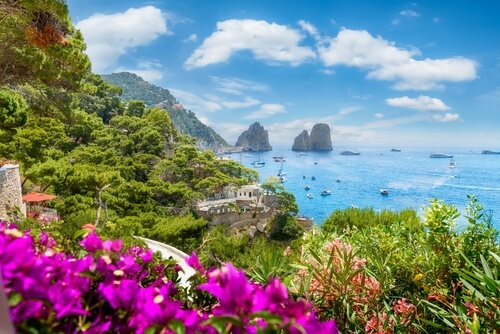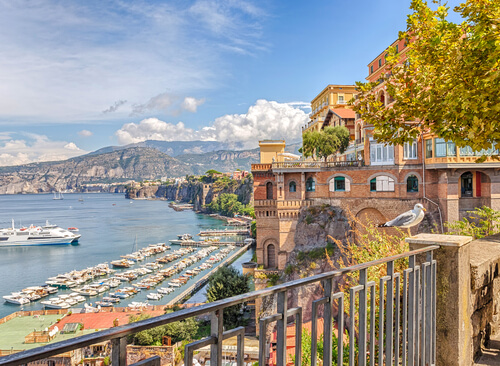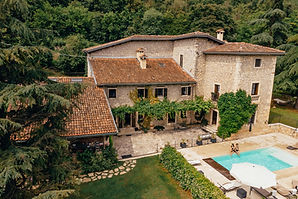Amalfi Coast
Travel Guide
Everything you need to know
Where is the Amalfi Coast
The Amalfi Coast (Costiera Amalfitana) is a stretch of coastline in the Campania region in southern Italy. It overlooks the Gulf of Salerno and the Tyrrhenian Sea whilst behind it is Monte Lattari. Nearly 55 km long, it stretches from Positano to Vietri sul Mare. It includes 13 seaside towns in total, among them Amalfi, Praiano, Ravello and Maiori.
The Amalfi Coast is known for its spectacular coastline. Dramatic cliffs, picturesque pastel-coloured topsy turvy towns, shimmering bays, enchanting coves and terraces dotted with lemon groves, vineyards and olive trees, all contribute to its breath-taking beauty. A UNESCO World Heritage site since 1997, the Amalfi Coast is the perfect place for a villa holiday in Italy if you want to experience la dolce vita.
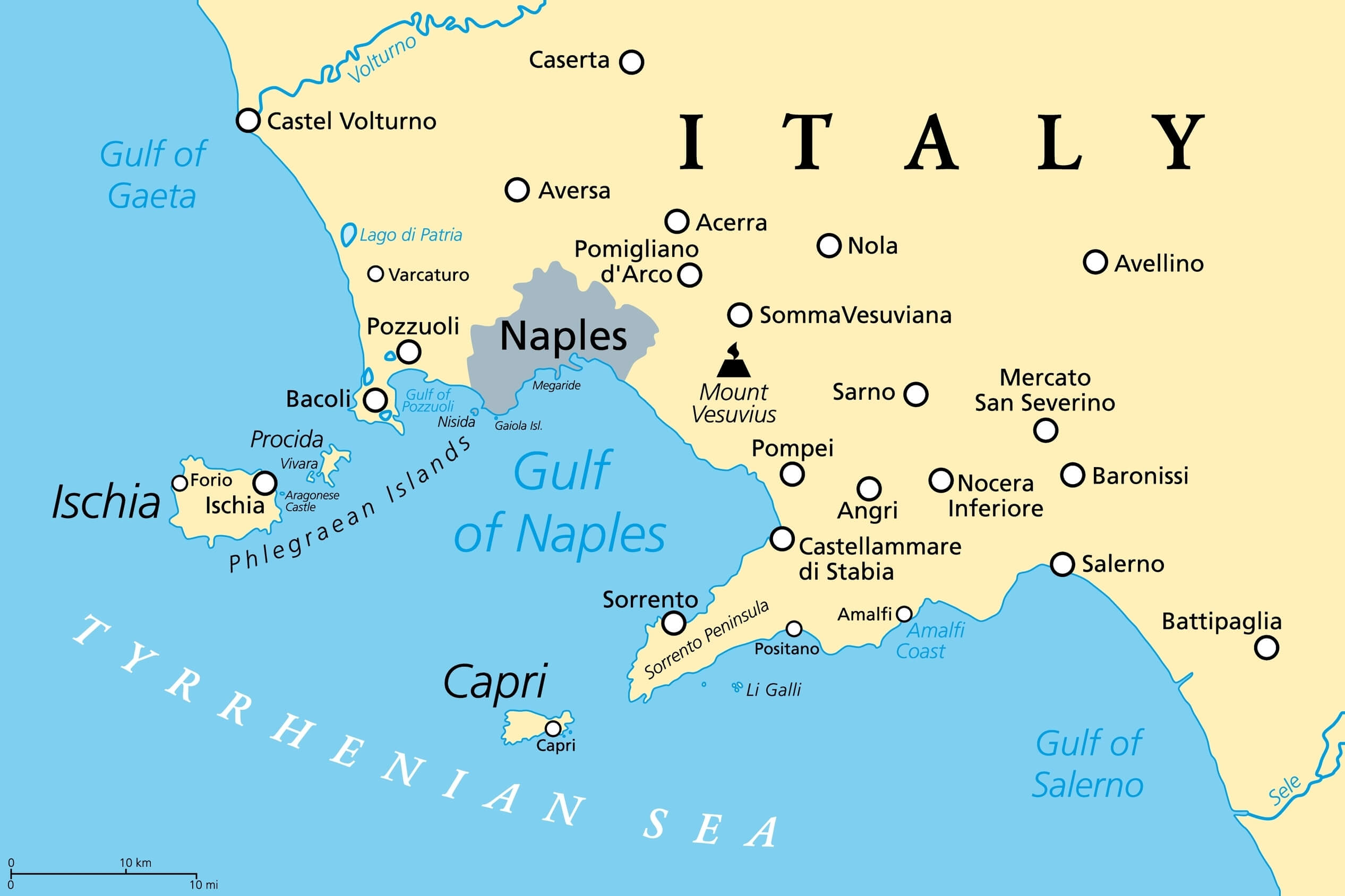
How to get there
The Amalfi Coast is one of our Italy villa holiday destinations where we often tend to discourage renting a car. As a result, it’s extremely convenient that it’s so easy to reach using public transport.
By Plane
The closest international airport to the Amalfi Coast is Naples (NAP). This is just over 60 km from the Amalfi Coast. For travellers from the UK, you can fly directly to Naples from Bristol, Edinburgh, London, Brimingham, Leeds Bradford, Glasgow and Manchester. Some routes only operate seasonally. Airlines that operate these routes include British Airways, Easyjet, Ryanair and Jet2. The flight duration is typically 2.5 to 3 hours.
From Naples airport, you can then connect down to the Amalfi Coast by train, boat, bus or car. If heading to Sorrento from Naples airport, then Curreri Viaggi provide a direct bus service from Naples airport to Sorrento. Alternatively, should you opt to transfer by boat or train, the Alibus shuttle offers a cheap and convenient way to reach both the port and central train station.
At the other end of the Amalfi Coast, Salerno actually also has an airport – Salerno Costa d’Amalfi (QSR). It is about 20 minutes by car from Salerno itself. Flights here are extremely limited at the moment, but airlines do currently operate flights from France, Spain and other Italian cities to Salerno. However, with a new passenger terminal planned for completion in 2026, it may be one to watch in the future.
In the meantime, you may also want to look at flying into other Italian airports and connecting down to the Amalfi Coast from there. For example, you could opt to fly into Rome Fiumicino (FCO) and then connect from here to the Amalfi Coast by train, arriving in Naples, Sorrento or Salerno. You can be in Naples in just over an hour from central Rome, in Salerno in as little as 90 minutes and in Sorrento in less than 3 hours. Or, you could even fly into Bari (BRI) in Puglia but the transfer time would be longer. The fastest train from Bari takes less than 5 hours to reach Salerno but many journeys are between 6 and 7 hours.
By Train
Italy is, without doubt, one of the most friendly countries in the world when it comes to travelling by train. Using the fast train service from Rome, you can be in Sorrento in less than 3 hours. Or you could be in Salerno at the other end of the Amalfi Coast in just 90 minutes.
There are are also overnight trains from various Italian cities to Naples which is where the majority of visits to the Amalfi Coast start. The Intercity Notte runs from Milan and Turin to both Naples and Salerno. Or you can also reach Naples overnight from Bologna and Udine.
Good train links throughout Europe means you can even travel to Naples by train from the UK. Take the Eurostar from London St Pancras to Paris, then onto Naples or Salerno. The TGV or Frecciarossa is a high speed train that runs from Paris Gare de Lyon to Napoli Centrale, usually requiring a change at Milan en route. The journey is not to be taken lightly though – it will take around 24 hours from start to finish. But you could of course, stop en route to break up the journey.
Once in Naples, there are three different train operators that will take you to either Sorrento or Salerno. Both services are extremely frequent with multiple services leaving every hour. The journey time is approximately an hour.
From Naples to Sorrento, you can choose between the Circumvesuviana or the Campania Express. Both are privately operated. The Circumvesuviana is a commuter line. With multiple stops en route, it’s slower but on the plus side, it offers cheaper rates. In contrast, the Campania Express is run primarily for tourists and prices can be 2 or 3 times higher than the Circumvesuviana.
Alternatively, you could catch one of 40 trains from Naples to get you to Salerno run by Trenitalia.
Another option upon arrival at Naples train station, is to walk from here to the Piazza Garibaldi. From here, you can catch a Sita Sud bus to the towns along the Amalfi Coast.
Or if arriving by train in Salerno, walk the 400 metres to Via Vinciprova where you can catch a bus to towns such as Amalfi, Vietri sul Mare, Atrani, Positano, Minori, Maiori and Amalfi.
Find out all train times, prices and book tickets to the Amalfi Coast at Trainline. Or find out more about train travel in our useful guide to travelling by train in Italy.
By Car
If you are coming to the Amalfi Coast by car, then take the A14 if driving from the north. This road hugs the eastern coastline of Italy and connects Bologna with Taranto in Puglia. Alternatively, you could travel from the north on the A1 via Rome before switching to the E842 to get from west to east.
Italy does has a good road network and travelling by car tends to be easy and efficient. If you’re looking to get from A to B quickly, then it’s worth using the Italian Autostrada whenever possible. These are fast roads but you do have to pay to use them. Toll booths will either require immediate payment or ask you to take a ticket, in which case payment will be made when you exit the motorway. Payment can usually be made using either a credit card or in cash. Just make sure you choose the correct lane – telepass or biglietto. The telepass is a device that will automatically deduct the toll from your bank account. The likelihood is that you won’t have one of these so instead you should opt for taking a ticket (biglietto). You can check the official Autostrada website for more details and for guidance on routes and journey times.
However, you do need to be aware that once at the Amalfi Coast, it can be notoriously difficult to navigate. The landscape is beautiful but the hairpin bends and cliff top roads plunging into the sea below, makes driving difficult. These roads are hard enough to navigate at the best of times, but try and drive them whilst contending with the insane amount of traffic and with a massive bus coming towards you can be incredibly stressful. Not to mention that parking can be hard to find and shockingly expensive.
By Taxi
Taxis and private drivers are available for hire in Naples. They will sit and wait at key locations such as the airport, train station and port. A taxi ride from Naples to the Amalfi Coast can take anything between an hour and two hours, dependent on your final destination with costs anywhere from 100 euros up to 250 euros. Make sure you always agree a price in advance. Uber Premier does exist in Naples but only at a very limited level.
However, if you want to get from Naples to the Amalfi Coast, we strongly recommend you book a private driver in advance rather than jumping in a cab from a taxi rank. Welcome Pickups work with licensed local taxi drivers and is a good option for a private transfer.
By Boat
Several ferry companies run services to the Amalfi Coast.
From the Beverello port in Naples, there are direct ferries to Sorrento, Positano and Amalfi as well as to the islands of Capri, Ischia and Procida. Journey times vary between 40 minutes and 1.5 hours, dependent on your chosen destination.
Tickets can be purchased at Ferryscanner.
By Bus
Flixbus has routes from a number of major cities in Italy (as well as from elsewhere in Europe) to Sorrento on the Amalfi Coast.
During the Summer months, you can also get to Positano and Praiano from Rome’s Tiburtina train station. Leaving at 7.30 in the morning it arrives between 11.30 and 11.45. Or, with Marozzi Bus Journeys, you can also get from Rome to Positano or Sorrento.

How to get around the Amalfi Coast
Once you have arrived in the Amalfi Coast, you have a few options about how to get about during your holiday. But, with roads so busy and difficult to navigate, you will most likely find yourself using public transport much more than you normally would during your Italy villa holiday.
Public Transport
Not many towns in the Amalfi Coast are reachable by train. In fact, only Sorrento, Vietri sul Mare and Salerno have train stations. That said, if you are also exploring the pensinsula’s west coast, then Sorrento, Vico Equense and Castellammare are connected by the Circumvesuviana trainline. This route also provides important connections to Pompeii and Herculaneum, both historic attractions which visitors tend to include on their Amalfi Coast villa holiday. Incidentally, this part of the Sorrentine peninsular is also connected via the EAV buses.
Instead, we recommend you use the extensive bus or ferry network to get from A to B on the Amalfi Coast.
The towns between Amalfi and Salerno are super easy to reach using the 5570 SITA bus network. This bus will also get you to the Grotta dello Smeralda and to both the Fiordo di Furore and Conca dei Marini beaches. The exception to this is Ravello. Since this town sits slightly inland, you’ll need to change onto the SITA 5110 from Amalfi to get here.
If wanting to hike along the Path of the Gods (Sentiero degli Dei), and we highly recommend that you do, take the 5080 SITA bus from Amalfi to Agerola (Bomerano) where the path starts. Hike the 7 km trail to the finish point at Nocelle before tackling the 1700 steps from here to Positano where you can get back on the bus. Of course, you can also complete the walk in the opposite direction but we recommend this way. It means you will be predominantly walking downhill. Plus, the views towards Capri and Positano are best seen this way round too.
Top tip: When using the bus network, make sure you choose a window seat on the side nearest to the sea to ensure you get to enjoy the best views.
If you prefer to use the ferry network, then there are three main companies that run services between the main towns of the Amalfi Coast. These are Travelmar, Alilauro and NLG. As a general rule, ferries are much more expensive than buses. They’re also not as frequent and most are seasonal, operating only between April and November. But in their favour is the fact that they won’t get snarled up in traffic like the buses can. This can be a huge plus, particularly in the peak Summer months. Purchase tickets at Ferryscanner.
You can also use the Trainline app for all bus and train ticket purchases and to plan your journey.
Renting a car and driving
Driving a car in the Amalfi Coast is certainly a challenging experience. Particularly in peak season between May and October, and between the hours of midday and early evening, the heavy traffic, winding roads and sharp hairpin turns, call for drivers with experience and skill.
In fact, so heavy is the traffic that the local authorities have put in place an alternate license plate system between June and October. On certain days, this system restricts vehicle access, so that vehicles with registration plates ending in an odd number can not drive on certain days, and likewise for those plates ending in an even number. This applies to both residents and rental cars.
The 55 km long SS163 is the main coastal road. It is notoriously narrow and driving on it is slow. Bikes, scooters, cars and even pedestrians are sharing a small space. Not to mention the massive SITA buses which seem to come out of nowhere on each blind bend. The tailgating by locals that know the roads well simply adds to the pressure. Whether it’s your own car or a rental car, either way you’re going to be paranoid about getting it scratched as vehicles squeeze past one another. In short, the concentration required to drive it means this can be both a stressful and tiring experience if you’re at the wheel. Certainly, this is not a route any newly qualified driver should attempt!
That said, for those brave enough to attempt it, there are rewards. The SS163 is one of the most beautiful coastal roads in Italy. Opting to drive it gives you the freedom and independence to go at your own pace and to stop at each photo opportunity and lookout point. It also enables you to visit those parts of the Amalfi Coast less easy to access using public transport such as mountain villages such as Agerola or Tramonti. You may also need your own car to access your chosen Amalfi Coast villa rental.
If you do opt to hire a car, we recommend you choose as small a one as possible. Stay alert when driving and use the mirrors that are positioned on the roads to give you greater visibility of oncoming traffic. Try and avoid driving at peak times of day. And, where possible, park in public car parks rather than trying to find a space on the roadside.
Drivers should also be aware of Zona Traffico Limitato (ZTL). These restricted traffic areas prohibit non-resident vehicles from entering. There are ZTL zones in Amalfi, Maiori, Positano, Sorrento and elsewhere.
The aim behind ZTLs was to reduce pollution and limit damage to streets and buildings in the historic centres. However, they have also managed to create a much nicer experience for those exploring these historic centres on foot. The ZTL tend to be active during certain hours so you need to read the signage carefully.
Every entrance to a ZTL will be clearly signed indicating that you are entering a restricted traffic area. These signs consist of a white circle with a red border on a white background. The words ‘Zona a Traffico Limitato’ is clearly written above the circle, whilst below there will be information regarding the timing that the restrictions are in place. For example, a sign stating 8.00 – 20.00 would indicate that the restrictions are in place between 8 o’clock in the morning and 8 in the evening. Your rental car will not have a permit to access these areas. Nor will your own vehicle. The only exception will be if you have booked accommodation within a ZTL and your Amalfi Coast villa or hotel provider has already informed you that you are able to enter the area and have already taken a note of your car registration plate. If in doubt, check with them before entering.
Entrances will also be marked by security cameras. These will immediately record your registration number if you enter and a fine will be issued should you be breaking the restrictions. In fact, you can be fined multiple times – each time you pass a security camera, you can get a new fine. Since fines can be up to €300, it’s a costly mistake to make! Don’t think it’s OK to enter if you happen to see other vehicles inside the area either. Residents are normally allowed to enter as is public transport. And don’t be fooled by what your GPS or SatNav system might be telling you to do. They don’t always inform you that you’re entering a restricted traffic zone.
Taxi
Taxis and private drivers are available for hire in the towns along the Amalfi Coast. However, they don’t tend to sit and wait in taxi ranks. Instead, it’s more likely that you will need to call and request a driver in advance. Expect long waits if you have not booked in advance.
If you don’t fancy using public transport, you could hire a private driver for a day tour of the Amalfi Coast. In this case, most drivers will be with you for 8 or 9 hours and will stop at various towns along the coast. Get Your Guide have a number of private tour options to choose from.
Alternatively, Welcome Pickups work with licensed local taxi drivers and is another good option.
Cities and Towns on the Amalfi Coast
The Amalfi Coast is filled with charming villages and towns, many clinging to the rocks. Our favourites include Amalfi, Atrani, Maiori, Minori, Positano, Ravello, Sorrento and Vietri sul Mare. But this list is by no means exhaustive. Check out our A to Z guide to the Amalfi Coast towns and villages for a more comprehensive list.
Amalfi
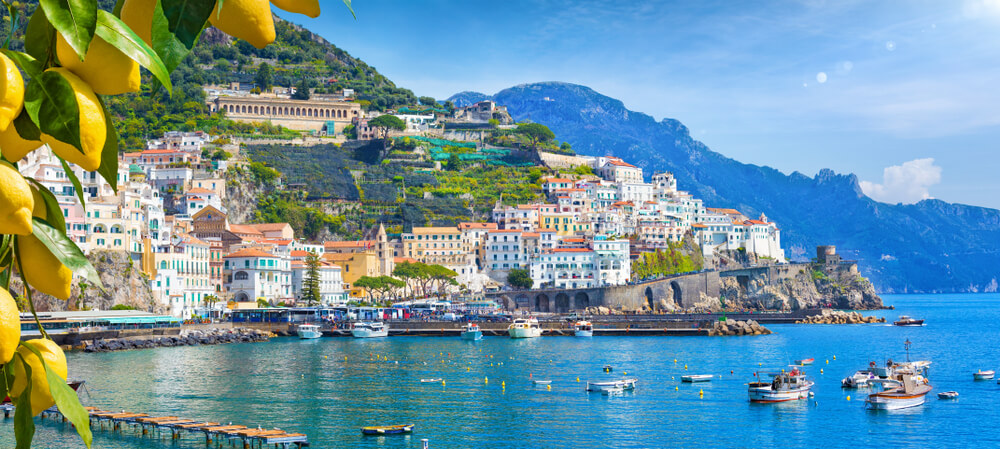
Introduction to Amalfi
Amalfi is the main town on the Amalfi Coast. It has been a popular tourist destination since the 1920s, when the British aristocracy and upper classes favoured Amalfi when completing their Grand Tour of Italy.
The highlight of a visit to Amalfi is the beautiful Cathedral of Saint Andrew overlooking the town’s most charming square. It consists of two juxtaposed basilicas. The oldest dates from the 9th century whilst the second was built in 987. However, the neo-Moorish facade dates to much more recent times. It was built in the 19th century after the original one collapsed. Make sure you don’t just visit the cathedral but also the Cloister of Paradise, the crypt and museum which are also part of the Duomo complex. Andrew is the patron saint of Amalfi and his relics are kept at the heavily decorated Cattedrale di Sant’ Andrea. Visit Amalfi on the 27 June or 30 November when the Corso del Santo takes place and you will witness a silver bust of Saint Andrew carried through the village and up the cathedral steps. Incidentally, when visiting Amalfi, you should stand at the top of these steps and take in the stunning views.
The Museo della Carta (Paper Mill Museum) in Amalfi is also worth visiting. This charming museum explores the history of the paper-making industry. It’s a family-friendly museum, with plenty of hands-on activities including the opportunity for you to make paper.
Amalfi also has its own beach. With the Gulf of Salerno on one side and picturesque views of the town in the other, it’s worth a visit even if you’re visiting off season. Even more breath-taking views can be enjoyed if you tackle the many stairs that lead from the town to Amalfi’s cemetery. There is a public lift that takes you to the cemetery if you prefer. We think this is one of the best viewpoints over the town. You’re above the cathedral and colourful rooftops looking down to the sea beyond.
If you have time, there is another lovely walk up through the back of the town, through lemon groves and ruined historic water mills (which would have powered the paper making industry centuries ago) to the Valle delle Ferriere nature reserve. The walk from the Piazza Duomo to the valley will take around 50 minutes but it’s definitely worth it. It’s a place filled with waterfalls, pools and nature.
Last but not least, as it is claimed that Amalfi is the birthplace of limoncelli, it’s also the ideal place to sample this refreshing alcoholic drink or to sample some of the other produce made from lemons grown in this area. Shops in Amalfi also sell everything from handmade leather goods to coral jewellery, beautifully painted ceramics and hand-made stationery.
Tips for navigating the city
The historic centre of Amalfi is a ZTL so if coming by car you will need to park up and walk in. Via Mansone I, the Piazza Duomo, Via Lorenzo d’ Amalfi, Via Pietro Capuano and Largo Spirito Santo are all pedestrianised and access to cars is prohibited to most vehicles. Real time information on parking can be found at Visit Amalfi.
Amalfi is a very walkable city. However, as with most of the towns on the Amalfi Coast, you should be prepared for plenty of steps! Amalfi’s main street is the Ruga Nova Mercatorum. This leads from the water and past the cathedral. Lined with souvenir shops and restaurants, it’s a great place to pick up a memento to take home with you.

Accommodation and dining recommendations
Amalfi is a good base for your Amalfi Coast villa holiday if you like to be somewhere more bustling with plenty of nightlife. If staying overnight in Amalfi, there are plenty of accommodation options on offer, suitable for all budgets. These include hotels in Amalfi, B&Bs as well as Amalfi apartments too.

As you’d expect being so near to the sea, there is plenty of fresh fish and seafood served up in the local restaurants in Amalfi. For a super typical meal, enjoy a bowl of scialatielli ai frutti di mare followed by delizia al limone. The latter is a sweet sponge cake filled with lemon cream, brushed with limoncello and covered in a whipped lemon cream glaze. It’s delicious!
After that, if you haven’t had enough lemons, there are plenty of opportunities to wash your food down with a glass or two of limoncello liqueur made from the lemons grown locally. Incidentally, the lemons in this area are typically twice the size of lemons you see elsewhere. They also have thicker, more wrinkled skins and fewer pips.
Atrani

Introduction to Atrani
Many may be surprised to see Atrani on our list. A small coastal town – in fact, it can claim to be the smallest town in Italy – what Atrani lacks in size, it more than makes up for in beauty. We think it is one of the prettiest villages anywhere in Italy and it comes as no surprise that it has served as the backdrop to a number of films. Perhaps more than any other town along the Amalfi Coast, Atrani has stayed true to its medieval roots. It is also a quieter alternative to its busier neighbour, Amalfi.
Narrow, winding streets, pastel coloured buildings that cling to the cliffs, flower-filled window boxes, quaint archways and charming courtyards characterise this charming Amalfi Coast town.
It is home to some stunning churches, among them the churches of Santa Maria Maddalena, Santa Maria Penitente and the 10th century San Salvatore de Birecto. A long white staircase leads to the entrance of this church marked by an incredible door, handcrafted in bronze.
And in the heart of Atrani is the Piazzetta Umberto I. Lined with cafes and restaurants, it’s where you will find the locals meeting to catch up on one another’s news. Fill up your water bottle in the fountain here and just enjoy a spot of people watching in one of the many cafes.
Atrani is perhaps most famous though for its stunning beach. Measuring just 130 metres in length, you will need to book your spot in advance if you want to reserve a sun lounger. However, there is a tiny free beach (spiaggia libera) too.
Behind this sits the Amalfi Drive and the 13th century Collegiate Santa Maria Maddalena church with its striking multi-level 16th century bell tower. However, for us, its the views from the terrace in front of the church that are most impressive. And it’s also where you will find a vibrant community of artists.
Tips for navigating the city
Atrani is incredibly close to Amalfi (it can even be reached on foot in just 15 minutes via a pedestrian tunnel from its busier neighbour), so it’s worth combining visits to these two towns. If you’re a keen hiker, then Atrani is accessible on foot from Ravello too. A pathway leads from the Church of Santa Maria del Gradillo in Ravello, through lemon groves and up and down ancient pathways, coming out at Atrani’s cemetery and the Church of San Michele Fuori Le Mura. From here, it’s a short walk in the central square – Piazzette Umberto I. The walk will take approximately 90 minutes.
Covering an area of just 0.2 square kilometres and with less than 1000 residents, Atrani is easily walkable. In fact, you would probably cover every inch of Atrani on foot in less than half a day! And as it’s so small, there is no chance of finding yourself lost either.
Being so small, there is also very little parking and traffic is heavily restricted. As a result, we advise you make your way there using public transport. There is no train station near Atrani but you can catch a bus from Amalfi to Atrani for less than 2 euros. And buses will also go to and from Atrani from other Amalfi Coast towns too. Alternatively, you can opt to take a taxi there. Just a word of advice: Check for an estimate of how much the journey will cost before climbing aboard to avoid any unpleasant surprises – this is not a cheap way to travel.

Accommodation and dining recommendations
If you prefer to stay somewhere slightly off the main tourist trail and are looking for a more sedate pace, then Atrani is a great option. It can also offer better value for money than some of the more famous towns of the Amalfi Coast.

Atrani is famous for a dish called sarchiapone. This is essentially a gourd stuffed with minced meat, cheese, eggs and bread before being fried and baked in a rich tomato sauce. The dish is traditionally served for the Feast of St Mary Magdalene celebrated on 22 July. However, you should find restaurants in the town serving it all year round.
For a sweet treat, try the Pasticciotto Atranese. More commonly found in Puglia, this take on a pasticciotto has crumbly pastry wrapped around custard and black cherries and lemon. It is delicious!
Our favourite restaurant recommendation in Atrani would be Ristorante Savo. However, for great views accompanied by great food, head to Le Palme.
Maiori

Introduction to Maiori
Maiori has a relaxed, friendly vibe. Since Maiori has the largest beach along the Amalfi Coast, it’s also a great base for families. On its largest beach, the fine white sand stretches over 1 kilometre and is mostly taken up with private beach clubs. Here, sun beds and colourful parasols are neatly lined up in rows. But for those who don’t want to pay for the additional services that these clubs offer, then there is also a free public beach section too. A second beach in Mairori is much smaller. This is Erchie beach, overlooked by two Norman towers – Torre Normanna and La Cerniola.
The mid 16th century Norman towers have become the symbol of this town. Certainly, they are among the most striking of any that are dotted along the Amalfi Coast. We recommend visiting the tower at sunset when it is at its prettiest.
With a mix of both modern and traditional architecture, Maiori is definitely less ‘picture postcard’ perfect than most of its neighbours. However, there are still plenty of architectural gems to discover. The Collegiata Santuario di Santa Maria a Mare is famous for its beautiful majolica tiled cupola. Other churches worth visiting include the Church of San Francesco, the Church of Santa Maria delle Grazie, the Abbey of Santa Maria dell’ Olearia and the Chiesa di San Nicola de Thoro-Plano.
Also of note is the 11th century Castello of San Nicola. It sits above a hill overlooking the town and its worth a visit not just to visit the fortress and its ruins but also to admire the view.
If visiting Maiori, it is also worth catching a boat to the nearby Grotto of Pandora. Just a few minutes away, the cave can only be seen from the water. Its emerald green waters and dramatic rock formations means it’s a popular diving spot. It’s possible to go inside by boat if the engine is switched off. Whilst you are on the water, you should also visit the Grotta Sulfurea, accessible on a rowing boat. A spring feeds sulfuric waters directly into the grotto. Stop here for a swim.
Tips for navigating the city
Parking on the Amalfi Coast is always a challenge. There are very few free parking areas and if parking does exist, it can often be reserved for residents. It’s also rarely cheap. Even when parking can be found, the typical price for parking is 8 euros per hour. This is why we usually recommend taking public transport to get around. The SITA buses go to Maiori and are reliable. However, they can get crowded in the peak Summer months so be prepared for it to be standing room only on board.
An alternative way to reach Maiori is by boat. A limited boat service to Maiori runs in the Summer months. Once you arrive at the port, you’re within easy walking distance of the town centre.
If you are coming by car to Maiori, there is paid street parking on the waterfront in the town. It is marked by blue painted lines and costs a few euros per hour. You can also book some car parking in Maiori in advance. such as Parcheggio Mandara and Garage La Grotta.
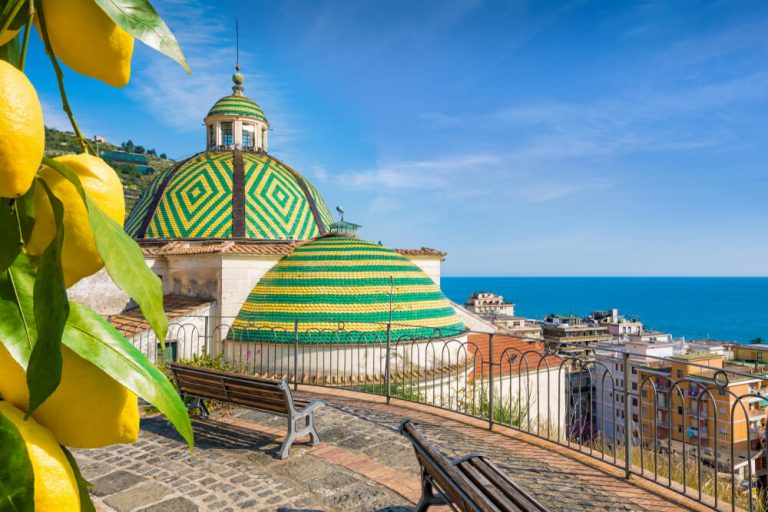
Accommodation and dining recommendations
With its larger beach, Maiori can be a great place for families to stay on the Amalfi Coast. There are plenty of accommodation options on offer, suitable for all budgets. These include hotels in Maiori, B&Bs as well as apartment and villa rentals too.

The fact that Maiori is widely regarding as less beautiful than other towns such as Amalfi or Positano, does have its advantages. You will certainly find that the Amalfi Coast villa rentals here are that little bit better value for money.
When it comes to dining, if you’re looking for a romantic dinner for two, we recommend Torre Normanna. If you’re after fine, Michelin starred dining with the most incredible views, book a table at Faro di Capo d’Orso. This is also the perfect spot for wine lovers. The restaurant claims to have more than 1000 different wines in its cellars.
Minori

Introduction to Minori
Maiori’s neighbour, Minori, is just as charming. Smaller and more compact than Maiori, it is also more picturesque. Just enjoy wandering aimlessly through its charming streets. You’ll soon come across its architectural gems. These include Minori’s cathedral. Dedicated to Santa Trofimena, the Basilica of Santa Trofimena is the most iconic of around thirty churches in Minori.
Also in Minori is the 1st century AD Villa Marittima Romana e Antiquarium. Excavated in the 1950s, this is home to some beautiful Roman ruins widely considered to be the most important anywhere on the Amalfi Coast. The building is centred around a traditional viridarium (open air atrium) with pool. Many of the original mosaics and frescoes are still visible today.
Finally, Minori’s beaches are worth spending time on, if only to enjoy the wonderful views of the azure seas that sit behind Medieval towers.
Tips for navigating the city
If you have already visited Maiori, then a fantastic way to get from Maiori to Minori is by walking along the Path of the Lemons (Sentiero dei Limoni). Shorter than the longer Sentiero degli Dei (Path of the Gods), it’s an incredibly scenic route through lemon groves. Don’t be surprised to pass locals working in the groves or even mules laiden with fruit. The walk takes approximately 90 minutes to complete, includes around 400 steps and does involve some steep ascents and descents. But you can always stop en route for a lemonade to catch your breath! Learn more about the area by booking a Path of the Lemons guided walk.
Incidentally, the path can easily be taken in either direction. If starting in Maiori, the path begins at the top of the steps to Via Vena at Santa Maria a Mare. From Minori, the path starts right in the heart of the town. And, if you do take this path, then make sure you also visit the hamlets of Torre and Villa Amena. Top Tip: If coming from Minori, make sure you also stop at the panoramic terrace – Belvedere della Mortella – which is just before you get to Torre and offers some of the most spectacular views anywhere on the Amalfi Coast.
If you are coming by car to Minori, there is paid street parking on the waterfront in the town, just like in neighbouring Maiori. It is marked by blue painted lines and costs a few euros per hour. There is also a small parking area at the end of Via Roma as well as on Via Gatto in front of the Hotel Europa.
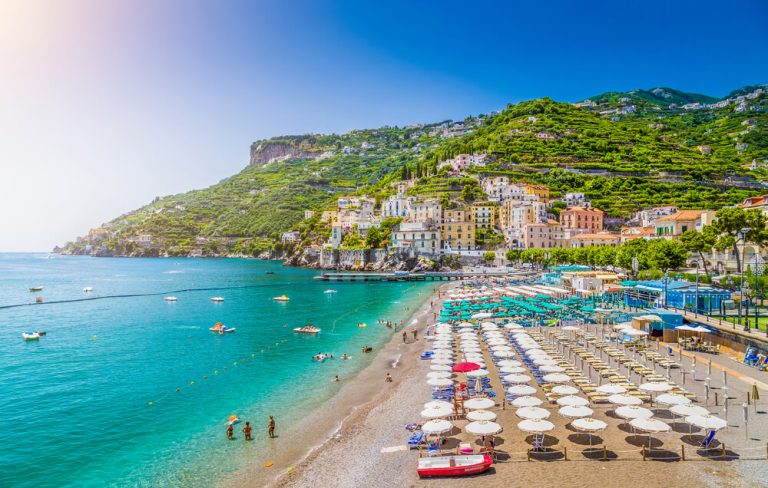
Accommodation and dining recommendations
As Minori is less famous that its neighbours – Positano, Ravello and Amalfi – it tends to offer better value for money when it comes to Amalfi Coast villa rentals or other accommodation options. Its position 20 km from Positano and 17 km from Vietri sul Mare also means it’s an extremely convenient base from which to explore the Amalfi coastline.
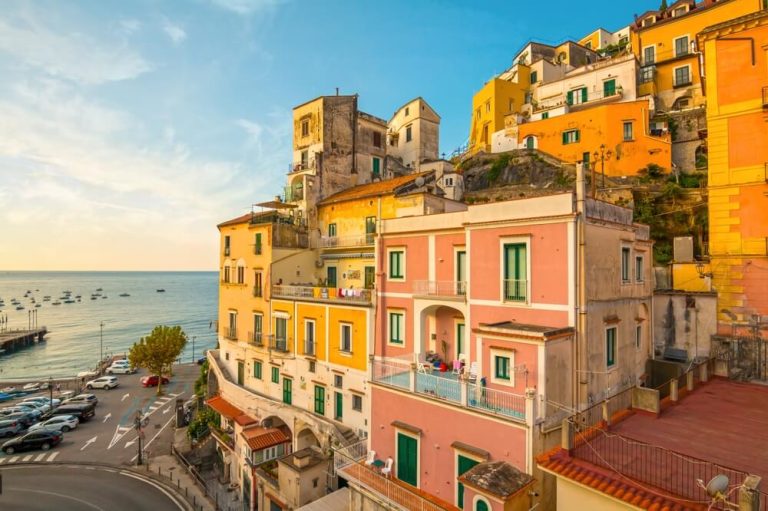
If you do head here, then definitely sample a bowl of pasta. In the 18th century, the town was famous for its pasta factories and its water mills. And we have certainly enjoyed some of the best pasta anywhere in Italy in Minori. Giardiniello is a firm favourite.
Make sure to also pop in to one of the many pastry shops to sample the Delizie ai Limone. These are small, cream-filled cakes topped with a thick layer of icing. Our favourite is the award-winning pastry shop Sal de Riso.
Visit in November to also enjoy the annual Film Festival which awards the Premio Internazionale Roberto Rossellini.
If staying in Minori, opt for a hotel or B&B in Minori or a Minori villa rental.
Positano

Introduction to Positano
Arguably the most famous town on the Amalfi Coast, Positano is a town that never fails to seduce its visitors. A vertical panorama of colour, the pretty pastel-coloured houses contrast with the green of Monte Lattari behind and the azure blue of the sea below.
Positano has a long and rich history – in Roman times, villas were built on its hillside, whilst in the eighteenth century it was a prosperous port and trading hub and more recently in the early twentieth century, it was popular with artists and celebrities including Steinbeck, Picasso and Elizabeth Taylor. These days Positano is a charming (and very popular) fishing village but you can find out more about its ancient history in the Museo Archeologico Romano
The majolica-tiled dome of the Church of Santa Maria Assunta is a focal point in the town. Head inside to see the Byzantine inspired icon of a Black Madonna dating back to the eighteenth century.
If you’re shopping in Positano, look out for the custom-made sandals. Head into one of the workshops, get your feet measured and you will have a unique pair of sandals within an hour. Also traditional in Positano are the pezza di Positano, traditional garments made from cotton, linen and silk and perfect to wear in the climate of the Amalfi Coast.
The town is also famous for its beach though. At 300 metres long, it is another of the largest on the Amalfi Coast. Expect a glamorous set to be sunning themselves here! For a quieter, more laid back vibe, head to the Fornillo Beach which is reach on foot along a path from Spiaggia Grande. Or catch one of the taxi boats that leave from Positano’s Marina Grande to smaller coves and bays nearby – Clavel, Cavone and Remmese. Since these can only be accessed from the sea, they tend to be quieter but reservations at some of the popular beach clubs – Da Adolfi and Bagni d’Arienzo – will be higher.
Tips for navigating the city
Positano is just 20 minutes from Sorrento by car and 75 minutes from Naples, traffic permitting. If coming by car, there is no free parking in the town centre itself though. Instead, the nearest free parking is in Nocelle and Montepertuso. These are both small hamlets in the hills above the town where you can then take a bus to Positano. It’s worth heading there to enjoy the view from here along the Amalfi Coast, over Positano and out to Capri and the Farglioni rocks.
There are some paid parking spaces on the roadside in Positano marked by blue lines. But chances of bagging one of these in the Summer months is almost non-existent! You may have more luck in the public car parks but, again, expect to wait patiently for one to become available! Those most conveniently situated to the historic centre are De Gennaro and Mandara. Expect hourly parking charges to be high.
Once in Positano, you need to be constantly prepared to be climbing steps. This is not a good option for the elderly or infirm.

Accommodation and dining recommendations
One of our Amalfi Coast villas in Positano is a great option if you’re looking for a base for your trip. This can often offer better value for money than a hotel in Positano, which you will probably find are premium priced given the popularity of the town.

When in Positano, make sure to visit Pinauro, a bakery famous for introducing Sfogliatella to Positano over 200 years ago.
Whilst you’re spoilt for choice when it comes to restaurants in Positano with good views (Ristorante Adamo ed Eva has particularly impressive views and food to match), do try Casa e Bottega for either breakfast or lunch. The focus here is frequently on raw ingredients and everything is incredibly fresh… and absolutely delicious! For a truly special steak or pizza, head to ROC. It is premium priced but worth every penny!
Ravello
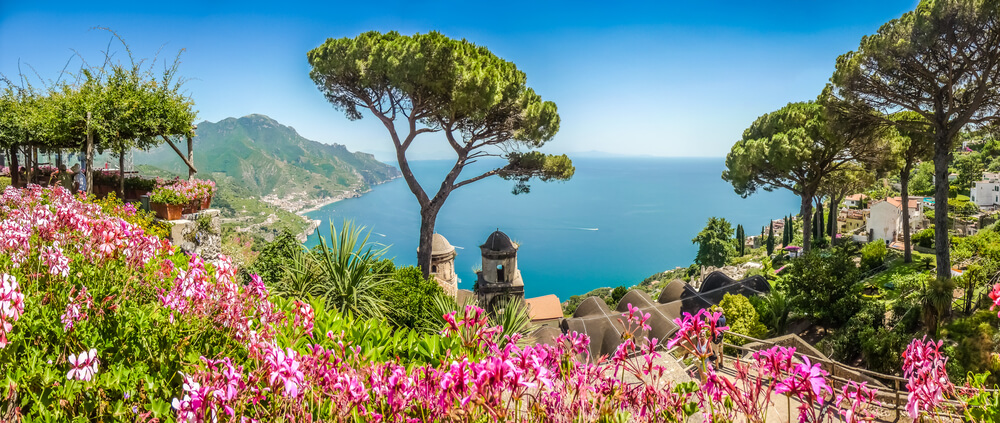
Introduction to Ravello
Ravello is absolutely stunning. At 365 metres above sea level, it is set in a more elevated position than many other Amalfi Coast towns and villages so that it enjoys views not just out to sea but also inland.
The Piazza Centrale sits at the heart of Ravello. Stop here for a coffee or bite to eat and just enjoy a spot of people watching. At nearby Piazza Vescovado, you will discover Ravello’s eleventh century Duomo with its magnificent bronze doors. Other churches worth visiting include the Chiesa dell’ Annunziata along with the interior of the San Giovanni del Toro.
However, Ravello is most famous for being home to Villa Cimbrone and Villa Rufolo. Villa Cimbrone is the most elegant of villas. It’s also where you will find the Terrace of Infinity. This viewpoint is iconic. At the end of a shaded garden path and accessed through an archway, the dramatic sweep of coastline, sea and sky sits behind weathered marble busts that line the terrace. It truly is breath-taking. Beyond the terrace, the rest of the gardens at Villa Cimbrone are well worth exploring. You’ll continue to be rewarded with wonderful views, not just out to sea but also inland towards Scala and the mountains.
Villa Rufalo is also famous for its gardens and views. It is no less beautiful but does have a different feel to Villa Cimbrone. Probably its most famous vista is that the lone umbrella pine tree with the coastline behind. Visit Villa Rufalo between July and September to enjoy the annual classical music festival. In fact, so strong is the music scene in Ravello that it has been nicknamed the City of Music. Concerts can be enjoyed not just in the magical setting of Villa Rufalo but also at the Oscar Niemeyer Auditorium. This is a very modern piece of architecture with a 400 seat auditorium. The chamber music concerts performed by the Ravello Concert Society.
The third view worth making a bee-line for in Ravello is at the Belvedere della Principessa di Piemonte in the gardens of the same name.
If you have time, enjoy the hike from Ravello to Mount Titano which will take you through vineyards.
Tips for navigating the city
Ravello doesn’t have the famous beaches of its nearby neighbours. That, combined with the fact that it’s a little bit harder to reach due to its higher hillside location, does mean that it tends to be a little quieter than other towns on the Amalfi Coast. It also means it’s a little harder to reach – there are no ferries that drop you off here.
It is possible to reach Ravello on foot from Amalfi. But this is not an easy walk to tackle, particularly if heading uphill. There are also series of paths and stairways from both Minori and Atrani to Ravello. The scenery is idyllic along each of them – cobbled paths, lemon groves, quiet courtyards and frequent glimpses of the sea – and you will be surprised by how few other visitors you pass. So if you do have the stamina, we can wholeheartedly recommend them.
If walking is not for you, or if the climb is too much, then it’s a case of taking the bus or catching a taxi (which will never be a cheap option). If arriving by road, you will need to exit the SS163 between Amalfi and Minori and head inland for approximately 3 km. The drive from Amalfi And Atrani takes just over 15 minutes, from Positano or Praiano it’s more like an hour.
Once in Ravello, the town centre is compact and easy to discover on foot.
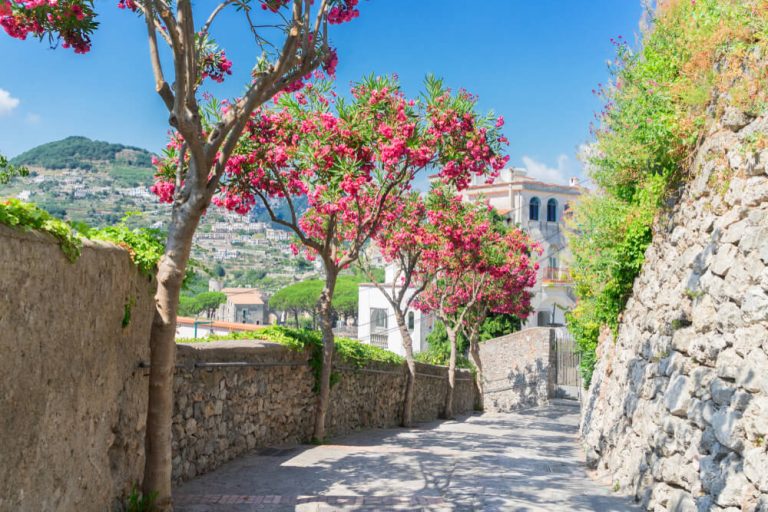
Accommodation and dining recommendations
Whilst Ravello may be quieter than other Amalfi Coast towns, it is also often the most expensive. However, it is worth spending one night here if you possibly can. That’s because, whilst most town and villages on the Amalfi Coast are worth exploring at the end of the day once the day trippers have headed home, nowhere is this more true than in Ravello. We recommend this not just because it will be more peaceful but also because there is something rather magical about the light in Ravello at this time of day.
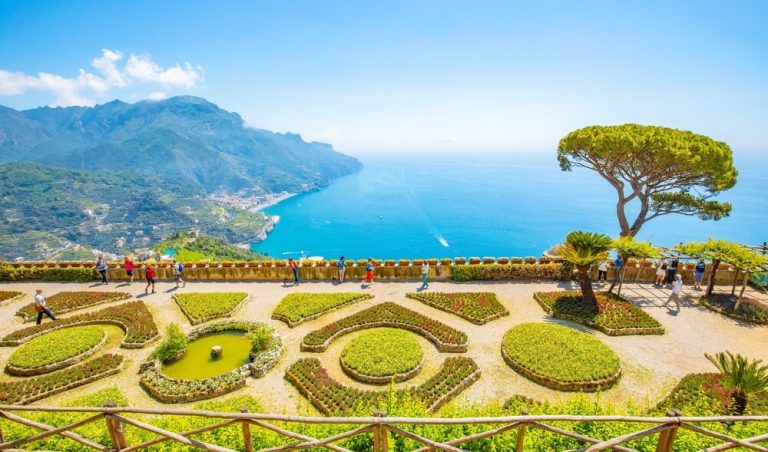
For the best gelato in Positano, head to our favourite gelateria – Baffone Gelateria. You’ll find all the usual flavours plus some more unsuual concoctions!
Or, if you’re looking for ingredients to whip up a feast back at your Amalfi Coast villa, then go shopping for cheese at Caseficio Straiano in Ravello.
Sorrento

Introduction to Sorrento
Not officially part of the Amalfi Coast but situated on the Sorrentine Coast, Sorrento is nevertheless a great base from which to explore the wider area. It has excellent transportation links to the Amalfi Coast and is within easy reach of both Capri and Pompeii.
The Piazza Tasso is Sorrento’s main square. It’s busy and bustling but we recommend you embrace and enjoy the atmosphere! Stroll around Sorrento’s streets to discover the Cathedral and Basilica di Sant’ Antonio as well as the nearby Cloister of San Francesco and the town’s museums. These include the Museo Correale (home to over 10,000 artworks) and the Museo della Tarsia Lignea. This is the perfect place to view traditional craftsmanship from this area. If you’re an art lover, then it is also worth heading to see the art exhibits on display in Villa Fiorentino.
From the Piazza Tasso, you can head to the Via Fuorimura where you’ll discover an incredible natural phenomenon – Il Vallone dei Mulino. Whilst you can’t head into the valley itself, you can view the abandoned gorge from above. The sight of the thirteenth century abandoned mills you see within it are pretty spectacular.
Or take the steep road from the historic centre down to the Marina Grande. Lined with pastel coloured buildings and some great restaurants, this has a much more traditional, rustic feel to the central Piazza Tasso. Also on Sorrento’s shoreline are a series of wooden or concrete piers and docks. These are perfect for sunbathing or jumping off from into the sea. There are also some tiny stretches of sand where you can hire a sun lounger and parasol.
For the best views in Sorrento, head to the Villa Comunale park. Here, a panoramic clifftop overlook boasts incredible views of the sea. The town also boasts some fantastic views of Mount Vesuvius.
Check out our Sorrento travel guide for more information about what to see and do in Sorrento.
Tips for navigating the city
Parking in Sorrento is easier than in the smaller coastal towns of the Amalfi Coast. If you are incredibly lucky, you may be able to find one of the few free public parking spaces marked by white lines on Via Rota and Via Parsano. However, we recommend you head to one of the public car parks or opt to pay for one of the blue parking spaces. There are public car parks on Via Fuorimura just a 5 minute walk from the Piazza Tasso or on Via San Renato. Alternatively, you can opt to book your Sorrento parking in advance. Just remember that the historic centre of Sorrento is a ZTL area and is closed to traffic at certain times of day.
To travel between Sorrento and the Amalfi Coast, you can take the regular ferry or SITA bus services.
You can also hire a kayak in Sorrento at the Marina Grande and explore the coast. If you’re fit enough, paddle your way to the Bagni Regina Giovanna, an idyllic natural swimming hole that was once home to a Roman villa.
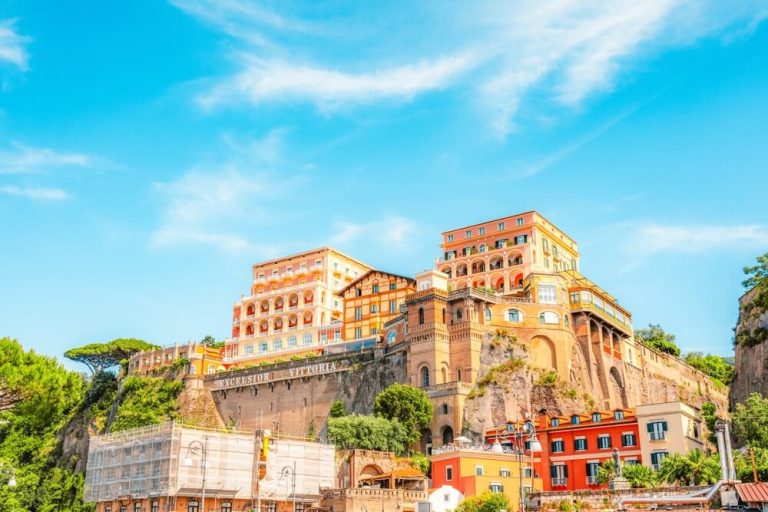
Accommodation and dining recommendations
Once in Sorrento, it is easy to navigate the town on foot. If you stroll along the Via San Cesareo in Sorrento, you are bombarded by shops selling limoncello. And no visit to the town would be complete without sampling this lemon liqueur. You can also learn how to make limoncello in Sorrento or enjoy a lemon tour and limoncello tasting.
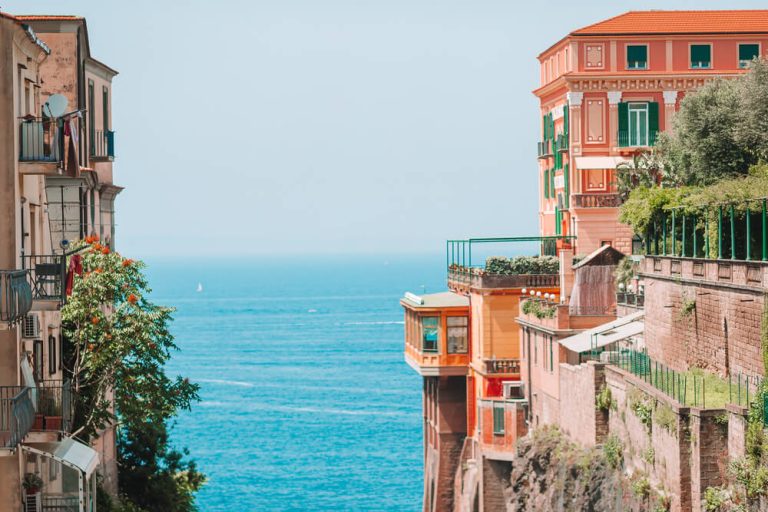
The traditional dish we recommend you sample in Sorrento is Gnocchi alla Sorrentina – it is the ultimate Italian comfort food.
However, if you’re staying in a villa in Sorrento, it’s not far to Gragnano. Gragnano is a town synonymous with pasta and, in particular maccheroni. The durum wheat used to make the pasta here is rather special thanks to both the microclimate in which it is grown and the traditional drying process which dries the dough in low temperatures over a long period of time. Grown in fields nestled against Monte Lattari, the durum wheat crop is subjected to a unique mixture of wind, humidity and sun that also means the wheat is a higher quality than elsewhere in Italy. Visit one of our favourite pasta producers in Gragnano – Pasta Somma – to enjoy a tour of the factory, meet the makers and even try your hand at pasta making.
Vietri sul Mare
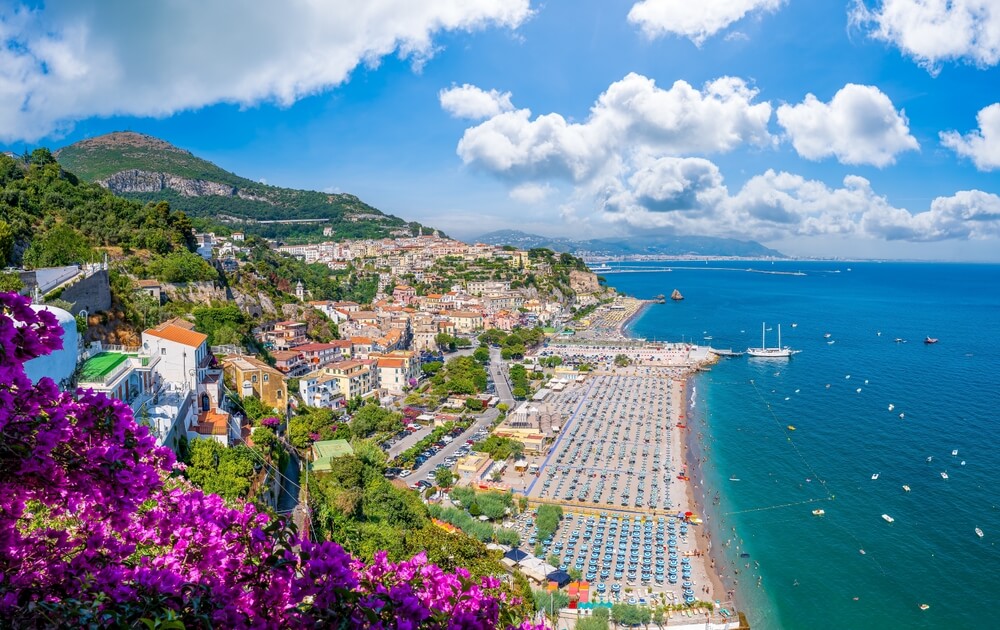
Introduction to Vietri sul Mare
Vietri sul Mare is a small coastal town with quaint streets. At each end of the town there is a panoramic piazza connected by the main street – the Via Corso Umberto I. A number of smaller side streets and hidden courtyards lead from here. Look out for the shops selling the bright, colourful ceramics that the Vietri sul Mare is famous for. Everything on display on the Via Corso Umberto I will be handmade and the choice is overwhelming. Our favourite store is Ceramica Pinto. However, if you’re after size, opt to visit the Solimene Ceramics Factory built by Paolo Soleri.
This majolica craftsmanship can also be admired in the decoratively tiled shopfronts, on paths and walls, and on the majolica-tiled cupola of the Church of San Giovanni Battista. It can also be found in the Villa Comunale park where a winding road and stairways are made using colourful tiles. This is where you can also enjoy breathtaking views over Vietri sul Mare, along the Salento peninsula and down to the Tyrrhenian Sea. The park is also home to a charming amphitheatre.
The tradition of ceramic making (majolica riggiola) dates back to the fifteenth century and gained wide recognition from the seventeenth century. Bright yellows, blues and greens are the most typical colours used. Decoration often fits into one of their common themes – rural agricultural and peasant life, coastal life, religion or lemons! Find out more about the history of ceramic making at the Museo della Ceramica in the hamlet of Raito. You could even book a hands-on experience and enjoy a ceramic workshop in Vietri sul Mare.
Those visiting Vietri sul Mare can also relax on the beaches. The largest lies to the west of the town. Here, the Marina di Vietri is one of the largest beaches anywhere on the Amalfi Coast. Lined with colourful buildings, it’s also extremely instagrammable. Look out in particular for a blue and pink house – Casa Colorata – adorned with tiles just across Via Cristoforo which is an iconic spot in Vietri sul Mare. However, don’t assume the size of the beach at Marina di Vietri will mean it’s easy to find a space here. It’s not. The proximity of Vietri sul Mare to Salerno means it can be super popular with locals. So arrive early to avoid the crowds and reserve your space. Copy the locals and jump off the Scogli I due Fratelli, rock stacks rising up from the water here. . Just a word of warning though – due to the proximity of Salerno, you won’t find the sea here as clear and sparkling as elsewhere on the Amalfi Coast.
Other beaches in Vietri sul Mare include the 400 metre sandy beach of La Baia however we don’t recommend this. As it’s at the eastern end of Vietri close to Salerno, it is not the cleanest. Instead, opt for the Spiaggia della Crestarella which is our favourite. This is a paid private beach.
Tips for navigating the city
Vietri sul Mare is certainly not as picturesque as other Amalfi Coast towns although we rather like its more weathered charm. But the location does make it more easily accessible, reached via the A3 highway between Naples and Salerno. In fact, just 10 minutes from Salerno, it is probably the easiest town on the Amalfi Coast to get to by car. It also has the most parking of any of the Amalfi Coast towns – you will find two good sized parking areas behind the beach. Not only that. It is also one of the few Amalfi Coasts towns to have a train station. The regional Naples to Salerno route stops here. Incidentally, the view as you exit the train station over the town below is stunning.
Alternatively, you can catch the bus. Bus number takes you from Postiano to Vietri sul Mare whilst the number
For those looking to do as much on foot as possible, from Vietri sul Mare is another hillside path. The Path of the Vietri Villages (Sentiero dei Borghi Vietresi) takes you on a bike through Vietri’s charming hamlets – Raito, Albori, Laconti and Dragonea. It is about 30 minutes on foot from Vietri sul Mare to Raito where the ceramics museum is located. However, if you prefer you can take bus 001 or 068 from the bus station in town to Raito. It will get you there in just 5 minutes. Albori is particularly beautiful and we recommend the walk.

Accommodation and dining recommendations
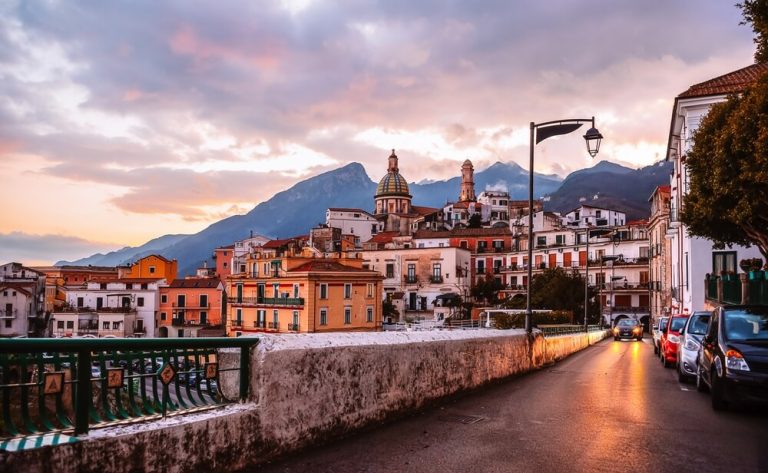
The fact that Vietri sul Mare is not as pretty as Amalfi or Positano also means it tends to attracts less tourists. Lower demand means lower prices. Find great value for money hotels in Vietri sul Mare, or explore our Amalfi Coast villas rentals if you’re looking for something with a little more privacy.
Things to do on the Amalfi Coast
History and Culture
The history of the Amalfi Coast stretches back millenia into pre-historic times. Evidence of Stone Age burials have been discovered in the caves along its coast for example, whilst the oldest known human footprints were discovered in Campania on the Roccamonfina Volcano.
It is perhaps Roman history that the region is most famous for though. Not far from the Amalfi Coast are the two archaeological sites of Pompeii and Herculaneum, both preserved by the ash and debris spewed over them when nearby Mount Vesuvius erupted in 79 AD. Back then, Pompeii would have been home to around 20,000 Romans whilst neighbouring Ercolano was a well-to-do Roman town with approximately 5,000 residents.

These days, visitors can stroll around the once bustling streets of Pompeii, admire the Roman graffiti, enter Roman houses and admire the many artefacts. Notable landmarks include the Roman Forum and nearby Tempio di Venere, Basilica and Tempio di Apollo. This is where you will discover the bronze statue of Artemis. North of the Forum are the Terme del Foro (thermal baths) whilst there is also a second set of baths at the Terme Stabiane. A third set of baths – the Terme Suburbane – sit outside the city walls. There was also an impressive gym in Pompeii – the Palestra Grande. Pompeii has two theatres too – the Teatro Grande and the elliptical shaped Anfiteatro. This would have once seated up to 20,000 spectators eager to watch the gladiator contests. These days it holds the title of being the oldest surviving Roman amphitheatre anywhere in the world.
There are also a number of Roman homes. Some of the most notable include the House of the Faun, the House of Tragic Poet (where a mosaic sits in the hall warning visitors to Cave Canem Beware of the Dog) and the grand House of Castor and Pollux. Equally lavish is the Casa del Menandro. Then there is the smaller but no less interesting Casa di Meleagro containing a fountain, fish pond and a simple fridge, as well as the Casa di Vetti which is home to some lavish paintings. And outside the walls sit the Villa di Diomede where 18 skeletons were discovered sheltering in the cellar when it was excavated, along with the luxurious Villa dei Misteri.
And visitors can admire Roman businesses too, similarly preserved in the ash. These include the Pistrinum (bakery), the Bottega del Fruttivendolo Felix (fruit shop), a laundry business and the Thermopolia which would have served hot food and drink to locals. Or, discover the seedier side of the city’s businesses along the Lupanare, Pompeii’s brothel quarters.
The archaeologist Giusppe Fiorelli poured plaster into the cavities left by the incinerated bodies in the ash, permanently freezing the incinerated victims and leaving a haunting reminder to today’s visitors of the human tragedy of the eruption.
Whilst it is possible to explore both without a guide, we do recommend a guided tour. At the very least, it will enable you to skip the queue to enter (which can be lengthy even with pre purchased tickets). But it will also give you a much deeper insight into Another word of advice: with very little shade, both sites can get extremely hot in the Summer months. Take plenty of water, wear a sun hat, wear sensible shoes and apply plenty of sunscreen.
And leave plenty of time to explore. Pompeii covers an area of 67 hectares and whilst not all has been excavated, you still need to leave at least 2.5 hours, ideally more, to do it justice.
Whilst Pompeii is the more famous of the two sites, arguably Herculaneum is actually the more well preserved. Again, there are a number of key villas and buildings. The Casa d’Argo and the Casa dell’ Albergo (where private thermal baths were discovered) are two of the city’s finest villas. However, also of note are the House of the Deer, the Casa del Tramezzo di Legno and the Casa dell’ Atrio a Mosaico and Casa dell’ Alcova. Or Herculaneum’s largest house is the three storey Casa del Rilievo di Telefo. Wine lovers should also explore the House of Neptune and Amphitrite, under which sits a well-preserved wine store. Public buildings include the Terme Urbane, the Terme Subrabane and Palaestra along with temples to Venus and other gods.
Incidentally, there are also three other smaller Roman sites – Oplontis, Stabiae and Boscoreale. Oplontis is home to the Villa di Poppaea, a rather lavish Roman villa which historians believe was the home of Nero’s second wife. Boscoreale is home to a fascinating museum filled with Roman artefacts as well as a number of other Roman villas. Additional villas can be visited at Stabiae. This is not a single site but instead more of a collection of buildings discovered over the centuries but it’s also well worth visiting. Save money by purchasing tickets for all five sites at once – a biglietto cumulativo.
Island Hopping
Whilst there is plenty to see on land along the Amalfi Coast, it can not be enjoyed to the full without taking to the water. Sitting off the Amalfi Coast are three islands – Capri, Ischia and Procida.
Capri is the closest and perhaps the most famous. The island oozes glitz and glamour. The boat will drop you at Marina Grande from where you can catch the funicular to Capri town. The island’s second main town is Anacapri. Whilst not as glamorous as Capri town, we actually prefer it – it feels that little bit more authentic. There are a number of other attractions on Capri. These include Roman remains such as Villa Jovis as well as gardens such as those at Villa San Michele and at the Parco Astarita. It’s also worth admiring the scenery from Capri’s viewpoints – look out for the Faraglioni rocks which have become a symbol of Capri. But probably the most famous attraction is the Blue Grotto, a cave whose water is quite a distinctive blue colour thanks to the light that streams through a hole in the rock. And, of course, if you want to enjoy the island at a slower pace, there are some wonderful beaches on Capri too. Our favourites include the Lido del Faro below the island’s lighthouse. Find out more in our Capri travel guide.
It takes less than 30 minutes to get from Sorrento to Capri. From Positano to Capri, journey times can vary, ranging from just 15 minutes to 40 minutes.

Ischia is the biggest of the three islands in the Bay of Naples. It is almost the exact opposite of its neighbour Capri. Don’t expect glitz and glamour here. Instead, Ischia oozes authenticity. Most famous for its thermal springs, there are a number of spas which provide access to the naturally hot thermal springs and mud baths But you can also access them for free. Hire a boat for the day and make your way around the island – you will spot the locals sitting in the sea water at Le Fumarole beach which is a sure sign that there are thermal springs below. Ischia’s next most famous attraction is probably the Castello Aragonese. Situated on a small rocky island linked to the mainland via a narrow bridge, holidaymakers can explore inside its walls to discover the Cattedrale dell’ Assunta, the Casa del Sole Museum, the Convent of Santa Maria della Consolazione and the cemetery of the Poor Clares. Towns on Ischia include Sant’ Angelo, Ischia Porto, Lacco Ameno and Forio. Find out more in our Ischia travel guide.
Finally, there is Procida. Measuring less than 2 square miles, this is the smallest of the islands and can easily be explored on foot. It has a charming atmosphere and is incredibly picturesque. Think pretty pastel-coloured houses, charming marinas and narrow streets, along with almost deserted beaches. The boat will drop you at Procida’s main port – Marina Grande. From here, walk for 15 minutes to get to Procida’s oldest fishing village – Marina Corricella – on the other side of the island. Also worth seeing is Marina Chiaiolella and the medieval fortified stronghold of Terra Murata.
Exploring the countryside
Spending time exploring the countryside of the Amalfi Coast is a refreshing contrast to discovering its famous seaside towns. It allows holidaymakers to enjoy a quieter, arguably more authentic side of the Amalfi Coast region.
Winding paths lead through terraced lemon groves, vineyards and olive orchards. The scent of citrus fruit fills the air. Here you will find small hilltop villages, often untouched by mass tourism and enjoying the most breathtaking views over the sparking sea below.

The most well known hiking trail is the Sentiero degli Dei (Path of the Gods). Eleven kilometres long, it goes from Agerola at one end to Nocelle at the other.We recommend you start in Agerola – this way, the walk will mostly go downhill. Crossing natural gorges and terraces plunging into the valleys below, the walk is demanding and requires phyiscal fitness, but the effort will certainly be rewarded. It offers the most extraordinary views.
Other hiking trails on the Amalfi Coast include the Path of the Lemons. This is a much shorter paved walk which should only take between 1-2 hours to complete. But again, there is still some exertion involved. We counted 400 steps both up and down! Also of note are the beautiful walks from Ravello to Amalfi and from Ravello to Minori but there are plenty more.
Beaches
The Amalfi Coast is well-known for its gorgeous beaches and picturesque coastline. Most Amalfi Coast beaches are pretty small but what they lack in size, they make up for in glamour and beauty! A couple of the largest beaches on the Amalfi Coast are those at Vietri sul Mare and at Maiori. And one of the longest (and sandiest) is at La Baia. We love the beach at Positano and the quieter beach at Laurito.

Some of the beaches on the Amalfi Coast are no bigger than small coves set into the rocks, only accessible by sea. As a result, it’s worth hiring a boat if you can.
And, of course, a day at the beach is also an opportunity to try out some of the water sports on offer. Kitesurfing and water skiing are both popular in the area as are non-motorised water sports such as windsurfing and kayaking. There are even opportunities to dive here. Beginners can complete their diving training at Villagio Nettuno.
Just a word of caution – many of the Amalfi Coast’s towns are situated high above sea level so be prepared to walk down a number of steps and steep pathways to access the beaches below. Also be prepared for crowds. Space on the beaches of the Amalfi Coast is at a premium in the peak Summer months. There are few public beaches and most of the beach space is fenced off by private beach establishments, which visitors can enter but for a fee. If we’re honest, there is nothing we love more than relaxing on a lounger at one of these beach clubs but it does come at a price. These neatly organised sun beds and parasols certainly means a day at the beach is not always a cheap family day out. However, there are some spiaggia libera (free beaches).
Wine Tasting
Whilst there is no disputing the fact that the Amalfi Coast is better known for its lemons than its grapes, it does boast some excellent wines. The vines are planted higher up in the mountains, usually on steep terraces, and have a special Costa d’Amalfi DOC status. Most of the wines are white – expect crisp, floral and citrus notes from varieties including the Fiano, Greco and Falanghina grapes. But there are also some reds – Aglianico and Piedirosso.
These are not easy grapes to cultivate. Because of their location, many of the slopes are only accessible on foot so everything must be done by hand.
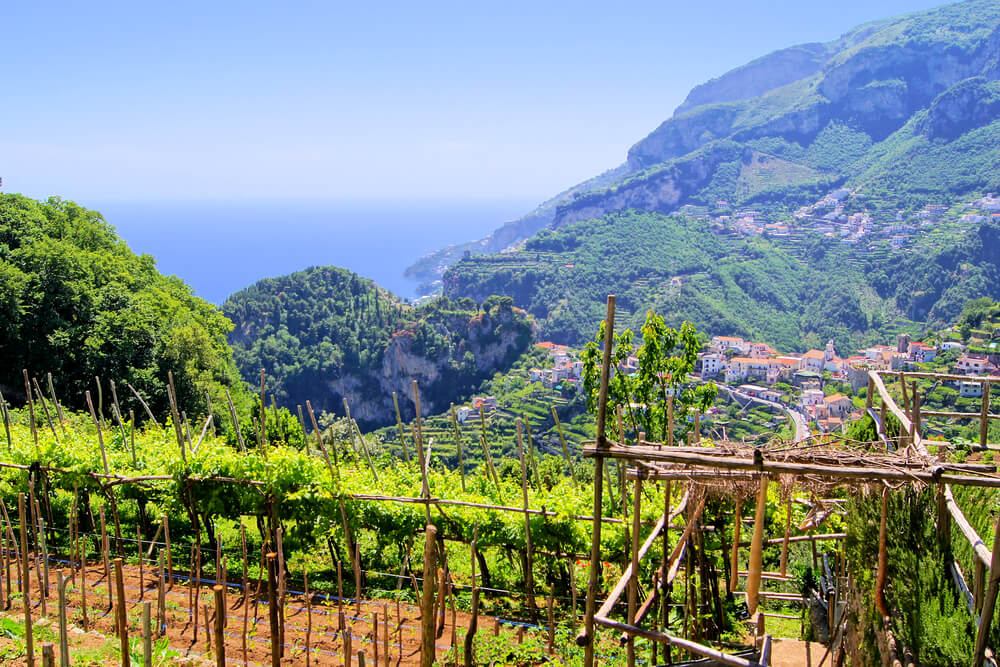
A couple of the most well-known vineyards on the Amalfi Coast include Marisa Cuomo and Tenuta Francesco which is on the hillside above Maiori. There is also a winery near the ruins of Pompeii and in the shadow of Mount Vesuvius – Bosco de Medici. One of our favourites is Le Vigne di Raito, a boutique organic winery. If you aren’t able to visit a winery in person, then a visit to Le Tre Sorrelle Wine Rooms in Positano is a great way to try a number of wines from the region in one place.
Best Places to Visit on the Amalfi Coast
The towns and villages of the Amalfi Coast – Amalfi, Maiori, Minori, Positano, Ravello, Sorrento and Vietri sul Mare to name just a few – are all worth visiting on your next Amalfi Coast villa holiday. However, there are other sites along the Amalfi Coast (and also off its coast) that should definitely make it on to your bucket list.
Mount Vesuvius
Sitting at over 1200 metres high, nine different colour-coded trails allow visitors to explore the Vesuvius National Park, home to an incredible variety of flora, fauna and animal species. We think the best time to visit is in the Spring when the slopes are ablaze with the bright yellow flowers of the broom which thrives here. Holidaymakers can take a walk around the rim of Vesuvius and peer into its crater.
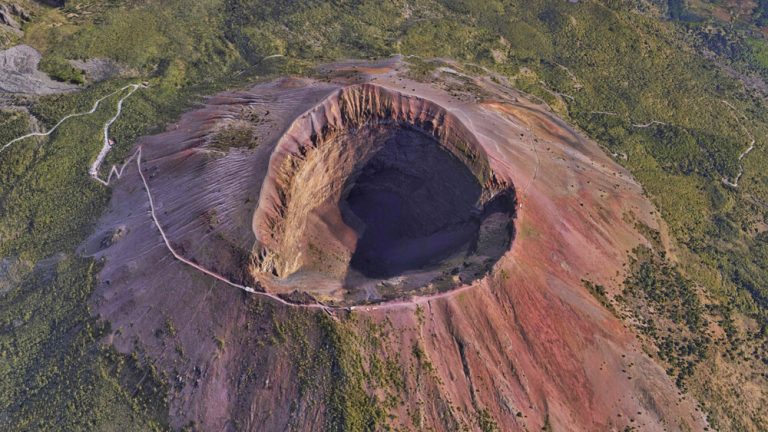
Pompeii
Pompeii, once a thriving Roman city of around 20,,000 people, was buried under ash when Mount Vesuvius erupted in 79 AD, preserving homes, streets, businesses and even casts of its residents. Today, visitors can explore the vast archaeological site, from grand villas and bath houses to bakeries, theatres and the oldest surviving Roman amphitheatre. With so much to see across 67 hectares, we highly recommend you take a guided tour of Pompeii to full appreciate its remarkable history.
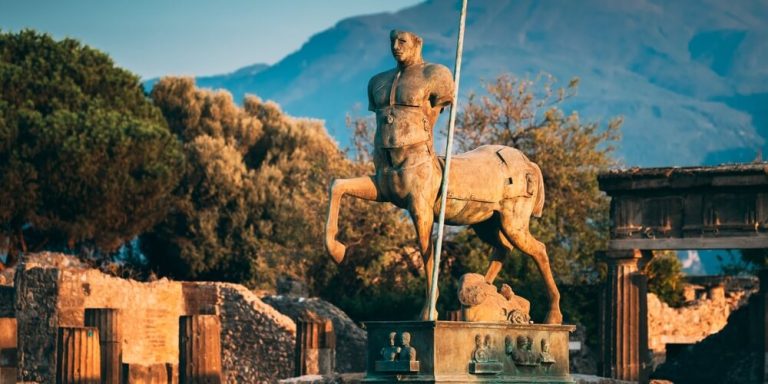
Herculaneum
Herculaneum, a small but wealthier Roman town than Pompeii, was also buried by Vesuvius in 79 AD. It is also even better preserved than Pompeii. Covered by 16 metres of ash and mud, even two storey homes have been preserved, along with impressive villas, mosaics and public baths.

Capri
Sitting 14 km from the Italian mainland, Capri is surely Italy’s most glamorous island. Once you arrive in Marina Grande, take the funicular from the port to the Piazzetta in Capri town. From here, head onto Anacapri to experience a slightly more laid back feel. For the most incredible views over the island, take the single seat chair lift to Monte Solaro.
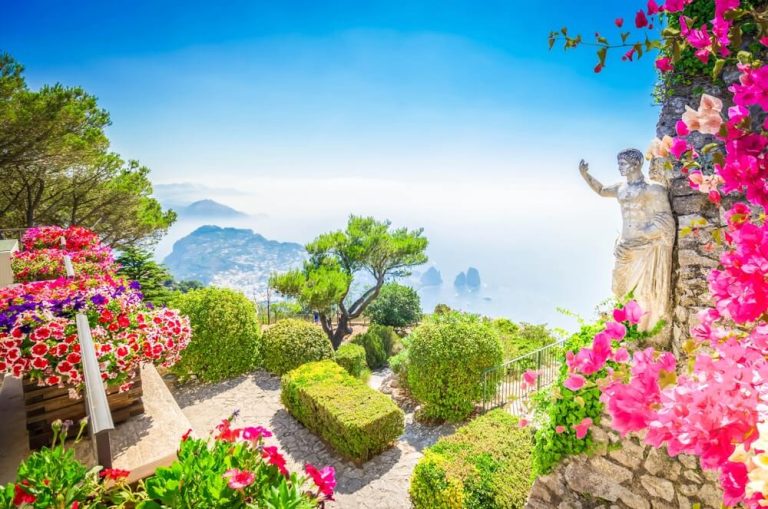
Ischia
The volcanic island of Ischia is dominated by its highest peak – Monte Epomeo. The island is famous for its thermal spas, beautiful gardens and Aragonese castle. If you’re feeling energetic, climb to the top of the volcanic peak of the 788 metre high Monte Epomeo. The views from the top are superb. After that, you can enjoy relaxing in one of the island’s hot springs or thermal baths.
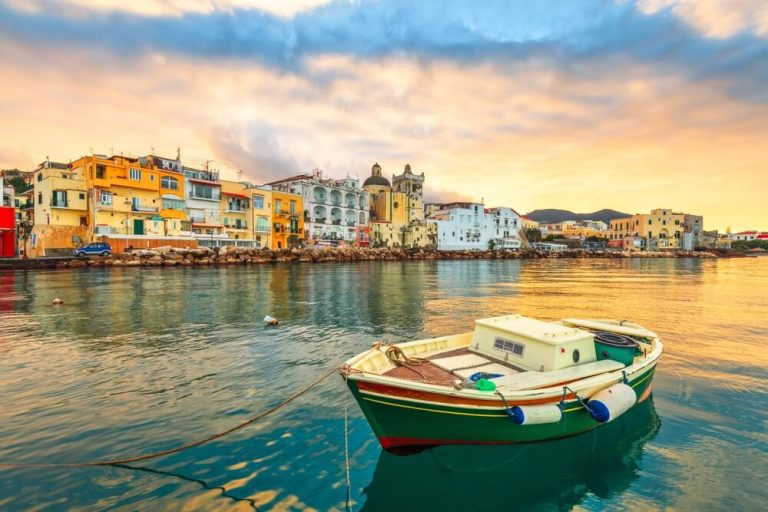
Procida
Sitting in the Bay of Naples, Procida is a small, colourful island known for its authentic charm. It enjoys a slower pace of life than its more famous neighbours, Capri and Ischia. Italy’s Capital of Culture in 2022, it remains a hidden gem where visitors can marvel at quaint fishing villages where pastel-coloured houses tumble down to the sea front. This is the perfect location to soak up authentic Italian island life.

Blue Grotto
The Blue Grotto is a cave on the island of Capri where sunlight passes through an underwater cavity to create a brilliant blue reflection illuminating the cavern. Once inside, the cave measures 60 metres long and 25 metres wide. However, the mouth of the cave is just 2 metres wide. As a result, it is only possible to enter via small rowing boats, each holding a maximum of four passengers. In peak season, this can mean a lengthy wait to be able to experience the phenomenon for yourself.
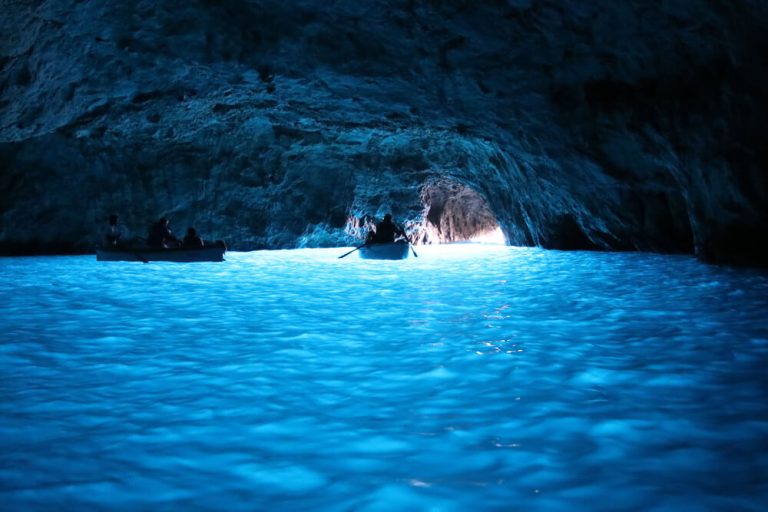
Path of the Gods
The Path of the Gods gets its name from the panoramas that are so breathtakingly beautiful that they seem almost divine. The 11 kilometre path is not for the feint hearted, winding high above the Amalfi Coast in the Lattari Mountains. But the rewards are many – sweeping views of dramatic cliffs, terraced vineyards and the sparkling sea below.
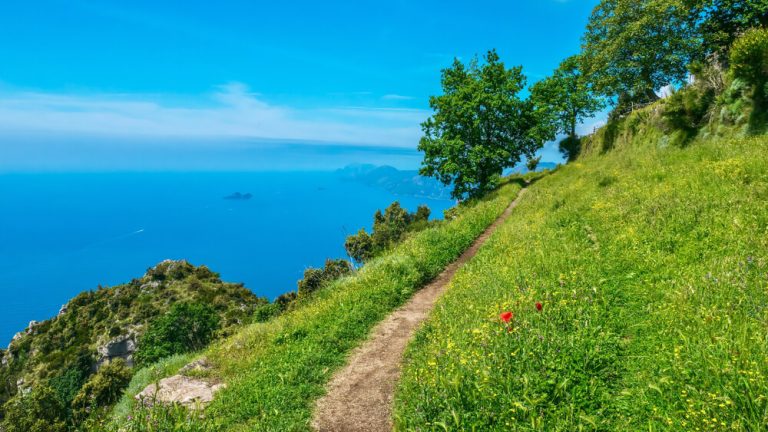
Naples
Whilst not on the Amalfi Coast, most holidaymakers visiting the area fly into the city of Naples. The third largest city in Italy and the capital of the Campania region, Naples does have a rather dark and gritty reputation. But don’t let this put you off visiting. Enjoy pizza in its birthplace, visit the Chiostri di Santa Chiara, the Via san Gregorio Armeno and the Piazza del Plebiscito. Find out more about the city in our Naples travel guide.
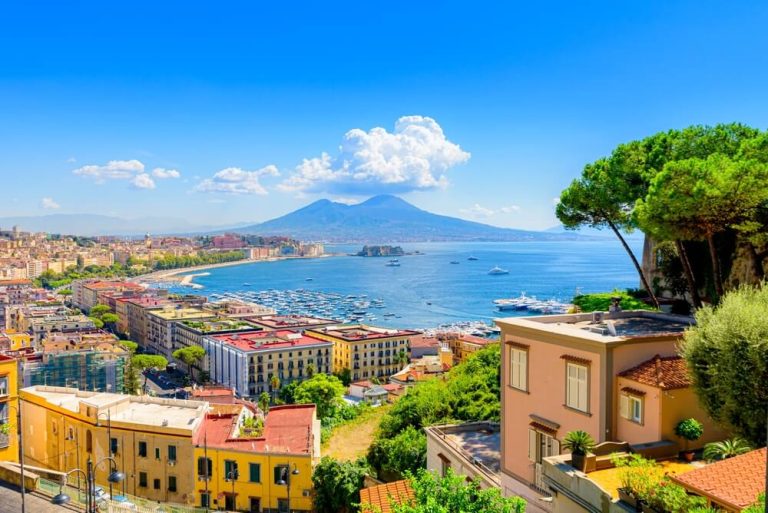
What to Eat and Drink on the Amalfi Coast
As you can would expect from any Italian region, Campania is no different when it comes to having its own food and drink specialities. Many of these originated from the Amalfi Coast. These are some of our favourite dishes that we recommend you trying during your Amalfi Coast villa holiday.

Spaghetti alla Nerano
A pasta dish that originated in the town of Nerano on the Sorrento peninsula, its ingredients are spaghetti, fried courgettes, provolone and parmesan cheese, fresh basil, oil, salt and pepper. Many have claimed to have invented this delicious recipe but most theories point to a Nerano restaurant owner called Maria Grazia. These days, you will find it on menus all over the Amalfi Coast.
Pasta al Limone
Another super simple dish that we recommend trying during your Amalfi Coast villa holiday is Pasta al Limone. Again, it’s super simple to make. Lemon zest and juice, garlic, butter and cheese are mixed together to create a rich sauce which is mixed with cooked pasta.
Scialatielli
This is the pasta shape that the Campania region and Amalfi Coast is famous for. Always made with flour and salt, its other ingredients sometimes include eggs and sometimes milk. You may also find it made with the addition of cheese or basil. It’s a short thick, often irregularly curved shaped pasta which holds the sauce well.
Look for dishes such as Scialatielli all’Amalfitana (or scialatielli ai frutti di mare) when it is served with seafood or Scialatielli alla Sorrentina when tomatoes and mozarella are mixed in. Incidentally, tomatoes and mozzarella are also mixed with gnocchi to create Gnocchi alla Sorrentina.
Spaghetti alle Vongole
Another seafood pasta dish that originated in Naples is Spaghetti alle Vongole (spaghetti with clams). Traditionally eaten by peasants, it’s an example of Italy’s cucina povera.
Ndunderi
Originating in Minori, but equally popular in neighbouring Maiori, Ndunderi is a type of gnocchi made with ricotta and pecorino cheese rather than with potatoes.
Ndunderi is our ultimate Italian comfort food, perfect to enjoy on a cooler Autumnal night in the Amalfi coast. Think mouth-wateringly light gnocchi baked in a deliciously rich tomato sauce and layered before being topped with sprigs of fresh basil.
Cuoppa di Mare
Another example of cucina povera, this also originated in Naples. Lightly battered and fried seafood (including prawns, squid, white fish, octopus) are served in a paper cone.
Insalata Caprese
The Insalata Caprese is one of our favourite Italian salads. Incredibly simple, it has just a handful of ingredients – juicy, ripe tomatoes, fresh mozzarella cheese and fragrant basil leaves, over which a smattering of olive oil is drizzled.
Again, there are plenty of theories around who invented it. Some say it was a patriotic bricklayer who created it to mimic the colours of the Italian flag. Others claim that it originated in the 1950s in response to tourist demand for a lighter dish that could be enjoyed in the hot sunshine of the Amalfi Coast. But we prefer the theory that it came from the Island of Capri itself. Here, the Grand Hotel Quisisana hosted a conference in 1926 where a simple salad of tomatoes, mozzarella and basil was served as an antipasto.
Whoever and wherever it was created, we can vouch for the fact that it makes the perfect starter or light lunch on a warm, sunny day in the Campania region.
Ravioli Caprese
If you’re looking for a hot dish that includes similar ingredients as the Insalata Caprese, then head to Capri to try their Ravioli Caprese. These pillow-shaped dumplings are filled with a variety of cheeses including mozzarella and caciotta. Marjoram is added giving it a unique flavour. These are then served with a simple but delicious fresh tomato sauce and topped with a sprig of basil.
Buffalo Mozzarella
Each region of Italy seems to have its own speciality of cheese. And in Campania, it’s buffalo mozzarella. Made from the milk of water buffaloes, it is used in numerous dishes from pizzas to salads and sandwiches.
Sarchiapone
Particularly famous in Atrani, this is a savoury dish made using gourd stuffed with minced meat, cheese, eggs and bread before being fried and baked in a rich tomato sauce.
In between Vietri sul Mare and Maiori sits the small fishing village of Cetara. It is famous for its fish sauce made using anchovies. Incidentally, you will also find a whole host of other dishes using anchovies in the village too.
Sarchiapone
In between Vietri sul Mare and Maiori sits the small fishing village of Cetara. It is famous for its fish sauce made using anchovies – Colatura di Alici. Incidentally, you will also find a whole host of other dishes using anchovies in the village too.
Delizia al Limone
For those with sweet tooths, this is a sponge cake filled with lemon cream before being brushed with limoncello and covered in a whipped lemon cream glaze.
Pasticciotto Atranese
Another sweet treat is the Pasticciotto Atranese. More commonly found in Puglia, this take on a pasticciotto by the bakers of Atrani has crumbly pastry wrapped around custard and black cherries and lemon. It is delicious!
Sfogliatella Santa Rosa
Looking almost like lobster tails thanks to their shape and layers, this sweet treat was created hundreds of years ago in the 17th century at the Santa Rosa di Lima Monastery. Whilst they can be found in any bakery in the area, we recommend you try and enjoy one in their birthplace – Conca dei Marini. This is one of the many charming villages along the Amalfi Coast. Whilst the Sfogliatella Santa Rosa are served topped with cream and a cherry, there are other variations.
Torta alla Caprese
Not wanting to be outdone by the villages on the mainland, Capri also has its own cake – the Torta alla Caprese. It is best described as a flourless chocolate cake made with almonds. It’s dense and decadent!
Limoncello
One of Italy’s most popular liqueurs, Limoncello is made by infusing lemon zest in alcohol and sugar syrup. Yet again, stories of its origins are many and varied, from it being created by monks and nuns to farmers and fisherman. What isn’t in doubt though is that is originated in Sorrento and the Amalfi Coast. To enjoy it at its best, enjoy it chilled after dinner. You will often find that restaurants in this area (and elsewhere in Italy) will offer a complimentary glass of Limoncello at the end of a meal for you to enjoy. Alternatively, to enjoy limoncello as an aperitivo, ask for a limoncello spritz. Limoncello, prosecco and soda water is poured over ice and served with a slice of lemon. It’s wonderfully refreshing on a hot Summer day.
The Best Time to Visit the Amalfi Coast
Spring is the best time to visit the Amalfi Coast. From April to June, the Spring flowers are in full bloom, mimosa and orange blossom fills the air, the temperature is pleasant without being stiflingly hot, and the sea is warm enough to brave the first swims of the season.
The start of Spring, April is the month when most businesses reopen for the season and you will find the ferry schedules begin a more frequent service connecting the various towns along the coast. Weather can still be a bit unpredictable but temperatures are mild – typically in the high teens – and as long as you’re not in search of a beach holiday, it’s the ideal time to explore the Amalfi Coast towns and villages.

Temperatures do increase as Spring unfolds – in May average highs are 24°C whilst in June they’re up at 27°C – so certainly by then you can combine beach days with sightseeing.
However, whilst it becomes hot enough to relax on the beach, you should find that it’s not too hot to hike the Path of the Gods, to enjoy day trips to historical sites such as Pompeii or to brave 24 hours in Naples.
Crucially, in the Springtime you have the added benefit of being able to enjoy these hiking trails and tourist sites without having to contend with the crowds. In fact, with the exception of the Easter weekend and Italy’s Spring bank holiday on 25 April and 1 May, you should find the Amalfi Coast pleasantly quiet at this time of year. You will see tourist numbers gradually increasing from May onwards but the busiest time of day in any town tends to be between 12 and 3 o’clock. Before and after the day trippers have arrived and left, places tend to be pretty peaceful.
Top tip: If you do plan to walk the Path of the Gods or visit the main archaeological sites, then try and do so on a week day – weekends are typically busier with the arrival of organised hiking groups and day trippers.
Springtime also sees a couple of important events in the region. These include Amalfi’s Regatta of the Ancient maritime Republics held every four years as well as Amalfi’s celebrations for the Feast of Saint Andrew on 27 June each year.
July and August are the busiest months on the Amalfi Coast, not just on shore but also off shore. In the Summer, luxury yachts bring in wealthy holidaymakers. At this time, there can be a danger that the surge of tourists can negatively impact the beauty and serenity of Italy’s most glamorous stretch of coastline. Expect roads to be snarled up with traffic and make sure you have plenty of time (and patience) to get from A to B.
That said, don’t let us dissuade you from visiting the Amalfi Coast in July and August. Just plan well ahead and book your travel and excursions in advance. In any case, even in peak season, there are still ways to escape the crowds. An Amalfi Coast private boat tour will allow you to enjoy the beauty of Italy’s coastline in peace. Or, you could even opt to hire a boat and navigate your own way along the Amalfi Coast. We can’t recommend this highly enough. Incidentally, if you do, look out for the bar boats which will pull up alongside you serving drinks and ice creams. There are also a number of ways to avoid the crowds on land too. For example, instead of opting to hike the Path of the Gods, choose to discover some of the lesser-known hiking trails further from the coast.
And there are plenty of festivals in July and August which are reason enough to visit the Amalfi Coast. These include the Festival of Lemons on the third weekend in July, the Ravello Festival at the end of August, as well as Ferragosto on 15 August. Whilst this is a national holiday, we think the Amalfi Coast celebrates it in style. Positano, for example, hosts a fantastic procession through the streets.
In any case, if you’re seeking heat, then you’ll wallow in the high temperatures at this time of year. Average highs sit at 30°C across both July and August and the chance of rain is extremely low. We recommend you spend your days at the beach. Again, hiring a boat means you can head to one of the beaches only accessible via the water to escape the bulk of holidaymakers. Restrict sightseeing to early morning or to the late afternoon and evening. And make sure you book your Amalfi Coast excursions and travel well in advance to avoid disappointment.
As we move through the year, September and October are also good months for an Amalfi Coast villa holiday. Average daily highs remain between 23°C and 27°C, businesses are still open and it’s much less crowded, particularly from the middle of September onwards when Italian schools go back. For us, this is almost as good a time as the Spring for an Amalfi Coast villa holiday. After all, the sea temperatures are higher than in April.
Don’t rule out visiting between November and March either. After all, this is the cheapest time to visit. However, if you do visit between these months, you should be prepared to find many shops and businesses closed. The Amalfi Coast can be particularly dramatic in these months and there is a beauty in its winter wildness. During poorer spells of weather, the waves crashing against the shore can often reach the balconies. But there is plenty to do even in wet weather. We recommend you opt to stay in a villa in Sorrento at this time – here, most shops and restaurants stay open all year round. And it’s a great base to enjoy day trips to Positano, Amalfi and Ravello as well as to Naples, Pompeii and Herculaneum.
We particularly like Sorrento in December. Sorrento is famous for its Christmas decorations, especially the tree in Piazza Tasso that has a music and light show on the dot of every hour. Whilst you won’t see any traditional Christmas markets on the Amalfi Coast, the other coastal towns are also still very pretty at this time, lit up with fairy lights and nativity scenes.
Even in March as Winter draws to a close, you will still find some businesses closed. Many places take advantage of this month to complete renovation works and finalise preparations for the upcoming season. However, visitors can expect to spot the first days of Spring. Just continue to pack sensibly if you’re planning your Amalfi Coast villa holiday this month. Throughout the Winter, you’ll need to bring your waterproof and plenty of layers (we like to call it dressing like an onion!) And and don’t expect to go into the sea unless you like cold water swimming. Average sea temperatures are just 14 °C!
How many days do you need on the Amalfi Coast
It would need at least 3 days to do justice to the Amalfi Coast. This would enable you to experience the key highlights, exploring towns such as Amalfi, Positano and Ravello. However, we would recommend a minimum of 5 to 7 nights if you want to enjoy a more immersive trip. The extra days would give you time to discover more of the smaller coastal villages off the main tourist trail, perhaps even one of the nearby islands, or enjoy a visit to Pompeii. You’d also have the time to simply relax, to discover some of the scenic walking routes or to spend time on one of the beaches. And a longer stay of 10 to 14 nights will enable you to experience it fully.
However much time you have for your Amalfi Coast villa holiday, we’d be absolutely delighted to help create a bespoke itinerary for your trip. Our itineraries will be tailored to the location of your Amalfi Coast villa and will reflect whether this is your first visit or whether you’re returning seasoned holidaymakers.
3 Days on the Amalfi Coast
If spending just 3 days on the Amalfi Coast, we’ve created an Amalfi coast itinerary that is all about soaking up the glitz, glamour and beautiful scenery of the area. As you have limited time in the area, it’s also ensuring you’re minimising journey times and providing an itinerary focused on the key highlights of an Amalfi Coast villa holiday.
We recommend you stay in Amalfi. You can then spend your first day exploring the town itself. Spend the second day discovering Ravello and Positano. Then, on the third and final day, you could enjoy a walk along the Path of the Gods, stopping for a leisurely lunch or dinner en route. Alternatively, you could choose a day trip to Capri instead. From Amalfi to Capri it’s only 50 minutes by boat.
Equally, you could switch the itinerary around, stay in Positano, spend the first day there, visit Ravello and Amalfi on day two and then copy the itinerary ideas above for your final day. A fast ferry from Positano to Capri will get you from A to B in less than 40 minutes.
5 Days on the Amalfi Coast
If you only have 5 days on the Amalfi Coast, you will still have to make some difficult decisions about what to include and what to cut out of your Amalfi Coast villa stay.
However, we recommend that you take our 3 day itinerary and expand it. You don’t need to choose between visiting Capri or the Path of the Gods. You have time to do both. Enjoy a whole day exploring Capri, take a ferry, tour the Blue Grotto and take the cable car from Capri to Anacapri to admire the incredible views.
You also have the time to book in an activity such as a cooking class, boat trip, a limoncello factory tour and tasting or a wine tasting experience in the hills above Amalfi. Here at Bookings For You, we’re big advocates of these immersive, hands-on experiences. They definitely provide the opportunity to create unique and authentic memories that stretch far beyond those you can create with just sightseeing on your own. They are also a way to foster genuine connections with the local community, deepening your connections and understanding of their traditions. They can even teach you new skills to take back home with you.
7 Days on the Amalfi Coast
If you have one week in an Amalfi Coast villa, then you can afford to be a bit more flexible about where you stay. Instead of basing yourself in Positano or Amalfi, you could also look at staying in an Amalfi Coast villa rental a little further afield such as in Sorrento.
You can also enjoy a more leisurely pace, mixing leisurely days with sightseeing and coast-hopping.
This means that when visiting Positano, you can afford to spend time not just exploring its narrow streets lined with pastel coloured houses and charming boutiques, but also spend time relaxing on its Spiaggia Grande beach, soaking up the atmosphere.
Likewise, when visiting Amalfi, you have plenty of time to visit its cathedral and the other attractions in the town centre. But you also have time to enjoy a leisurely walk to the Valle delle Ferriere or to enjoy a boat tour and snorkeling, a pasta making class or a pizza making lesson with a local family in a traditional farmhouse.
You can also afford the time to spend the whole day in Ravello. Here, visit the gardens at Villa Cimbrone and Villa Rufolo. They are breathtakingly beautiful.
And, of course, if you have chosen Sorrento as a base for your trip, then you will want to set aside a day to explore this town too.
You’ll still need to a day to visit Pompeii. Book a guided tour of Pompeii first thing in the morning – it means you will avoid exploring the site in the hottest part of the day – but, if you wish to, it will also allow you time to visit Mount Vesuvius on the same day. You do need to set aside at least 3 hours for Pompeii and between 2-3 hours to walk up to the volcano’s crater and back. As a result, it is a demanding day of sightseeing but definitely achievable. Alternatively, for a more relaxed afternoon, combine a visit to Pompeii with a vineyard tour, wine tasting and lunch on Mount Vesuvius.
As before, spend one day in Capri. And spend another day hiking the Path of the Gods. For a final treat, add in an evening sunset cruise on the Amalfi Coast. For the beauty of the coastline to be truly appreciated, it definitely needs to be seen from the water as well as on shore.
10 Days on the Amalfi Coast
10 days on the Amalfi Coast allows ample time to not just explore this stretch of coastline but also to spend a day in Naples too.
Alternatively, instead of adding in any additional stops, you can opt to enjoy our 7 day Amalfi Coast itinerary and just slow the pace a little.
But it you’re someone who likes to be constantly busy, then you could also choose to explore the other coastal towns along the Amalfi Coast – Maiori, Minori and Vietri sul Mare are all worth a visit.
14 Days on the Amalfi Coast
With 14 days on the Amalfi Coast, you can start to add in some less well-known spots. Instead of just walking the Path of the Gods for example, you can enjoy some of the lesser known paths such as the Path of the Lemons, the walk between Ravello and Minori or the Valle dei Mulini to discover the history of the paper making industry in the region.
Or instead of staying in the coastal villages, you could head inland to explore towns such as Gragnano. Here, you will enjoy some of the best pasta anywhere in Italy. Gragnano is just 35 minutes drive from Sorrento, 45 minutes from Positano and approximately an hour from Amalfi.
Alternatively, you could spend more time off the coast, discovering not just Capri but also Ischia and Procida.
Amalfi Coast holidays for...
The Amalfi Coast can have a broad appeal with plenty for all ages to enjoy. That said, we have some top tips to ensure that everyone enjoys their stay to the full, whoever you are travelling with.
For Couples
The Amalfi Coast is definitely one of Italy’s most romantic destinations. Think intimate restaurants, breathtaking views and enchanting sunsets. If you’re looking for a quieter, more serene spot, we recommend choosing Ravello as a base. Enjoy each other’s company on a private boat trip to a hidden cove or during a wine tasting at a hillside vineyard or gaze into each other’s eyes during a candlelit dinner overlooking the coast.
For Families
The Amalfi Coast is a great family-friendly destination. It combines cultural charm with experiences that all ages can enjoy. We think Maiori is a great place for families to stay thanks to its large beach. Or opt for Amalfi or Sorrento with their frequent ferry connections.
If you have older children who are confident in the water, then we highly recommend hiring a boat on the Amalfi Coast and getting out on the water as much as you can. On land, enjoy gelato-tasting strolls through the historic streets of the coastal towns and villages or enjoy a hike through the Valle delle Ferriere where the whole family can safely enjoy the beautiful countryside of the region.
Solo Travellers
Solo travellers will find the Amalfi Coast an easy region to explore at their own pace. Positano or Sorrento are lively choices, both offering opportunities to meet fellow travellers in beach clubs, bars and cafes, whilst also offering good transport links for both ferries and buses. Solo visitors can hike the famed Path of the gods, join a cooking class, enjoy a limoncello tasting or take a group boat tour. The welcoming atmosphere and vibrant social scene will ensure that a solo trip in the Amalfi Coast never feels lonely.
For Groups
The Amalfi Coast offers groups of friends and multi-generation family groups a great mix of fun, adventure and relaxation. An Amalfi Coast villa rental in Sorrento is a great base thanks to its larger accommodation options and ease of access to sites such as Pompeii, Capri and Naples. Together, groups can rent a private boat on the Amalfi Coast to enjoy island-hopping. Alternatively, enjoy a limoncello-making workshop together or just spend the day at one of the beach clubs on the Amalfi Coast.




